ISSN ONLINE(2278-8875) PRINT (2320-3765)
ISSN ONLINE(2278-8875) PRINT (2320-3765)
Pawan Yadav1 and Rita Mahajan2
|
| Related article at Pubmed, Scholar Google |
Visit for more related articles at International Journal of Advanced Research in Electrical, Electronics and Instrumentation Engineering
Cognitive radio (CR) is an emerging intelligent wireless communication technology .With the advance of wireless communications, the problem of bandwidth has become more prominent. Cognitive radio technology has come out as a way to solve this problem by allowing the unlicensed users to use the licensed bands . A limited available spectrum has been put to a lot of limitations by the exceeding demand of wireless applications. Recent study show that some frequency bands in the spectrum are mainly unused most of the time and some are less occupied.This leads to spectrum underutilization. Cognitive radio is one such technique to solve such spectrum problem. It is a technique in which secondary user searches for a free band to operate in while primary user is not using its licensed band. Spectrum sensing that enables the cognitive radio to search for the free bands. It helps to detect the spectrum hole so that they can be used by secondary user. In this paper a prototype system for designing and also explores Simulink based Energy Detection in a MATLAB Simulink
Keywords |
| Cognitive radio(CR), Spectrum sensing, Energy Detection(ED), Primary User (PU),Secondary User (SU). |
INTRODUCTION |
| Modern wireless systems offering a wide variety of high data rate applications to various users at the same time. In order to realize this objective, they have to overcome the practical constraints imposed by the resources they need such as power and spectrum, which are limited in nature. The number of wireless systems is increasing very fastly, the scarcity of these resources, especially of the frequency spectrum, becomes a problem day by day. |
| Cognitive radio is a concept that overcome to the problem by proposing an opportunistic spectrum usage [1] approach, in which frequency bands that are not being used by their licensed users are utilized by cognitive radios. Since cognitive radios do not need a license and they do not affect the operation of licensed systems, this approach leads to a highly economic and efficient usage of the frequency spectrum. The Federal Communication Commission (FCC) research report [2] show that, seventy percent of the allocated spectrum is underutilized. So we need a technique to deal with the problem of spectrum underutilization. Cognitive radio [3][4]can sense external radio environment and use past information. It can use unused spectrum band dynamically without affecting the primary users. |
| Basic function of cognitive radio is to sense the spectrum precisely by evading any chances of hindrance or interference to primary or licensed users. By using spectrum sensing, cognitive radios can adapt themselves to the eternal wireless network. All the cognitive radio users are divided into the primary user(PU) and secondary users (SU). PU can be defined as the user who has license to use a specific band of the spectrum. On the other hand, secondary users (SU) do have license to use the spectrum but can use the spectrum when PU is absent. When PU is present SU user shift its transmission to another frequency or changes other modulation parameters and never causes interference to primary users. Various techniques have been used for identifying the presence of the PU signal transmission. The existing spectrum sensing techniques can be broadly divided into three categories : energy detection, matched filter detection, and cyclostationary detection. Matched filter [5][6], energy detection and cyclostationary detection are widely used techniques as detection techniques. Among them, energy detection has been mostly applied because it does not require any a priori knowledge of the primary signals and has much lower complexity than the other two schemes. In addition, it does not need any prior information about the PUs' signals. |
COGNITIVE RADIO |
| A Cognitive Radio is a adaptive multi-dimensionally aware intelligent wireless communication system that learn from its experience to reason, plan and decide future action to meet consumer needs .The two important characteristics of cognitive radio are:- |
| (a) Cognitive capability- Cognitive capability refers to the ability of the cognitive radio technology to capture or sense the information from its radio environment. |
| (b)Reconfigurability- Reconfigurability enables the cognitive radio to be programmed dynamically according to the radio environment [7]. |
| Cognitive Radio mainly does four functions |
| Spectrum Sensing: Cognitive Radio continuously looks for the unused spectrum which is known as the spectrum hole. This property of cognitive radio is termed as spectrum sensing. |
| Spectrum Management: Once the spectrum holes found cognitive radio selects the available hole or channel. This property of cognitive radio is termed as spectrum management. |
| Spectrum Sharing: Cognitive Radio allocates the unused spectrum (spectrum hole) to the secondary (cognitive) user as long as primary user does not need it. This property of cognitive radio is termed as spectrum sharing. |
| Spectrum Mobility: Cognitive Radio vacates the channel when a licensed (Primary) user is detected. This property of cognitive radio is termed as the spectrum mobility |
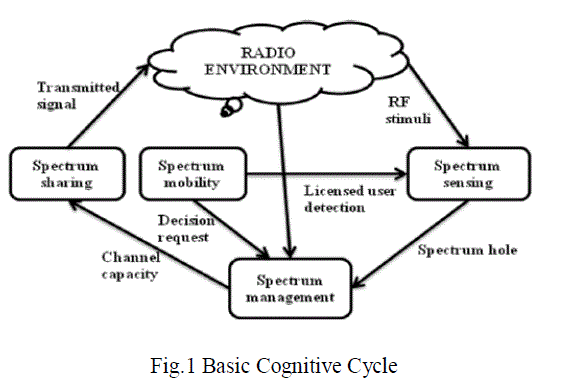 |
SPECTRUM SENSING TECHNIQUES |
| There are various spectrum sensing techniques which are employed for spectrum sensing such as:- |
(1) Matched Filter Detection |
| The matched filter (also referred to as coherent detector), it can consider as a best sensing technique if CR has knowledge of PU. It is very accurate because it maximizes the received signal-to-noise ratio (SNR). Matched filter correlates the signal with time shifted version and compares between the final output of matched filter and predetermined threshold will determine the PU presence. Hence, if this information is not accurate, then the matched filter operates weakly. |
(2) Cyclostationary Feature Detection |
| Implementation of a Cyclostationary feature detector is a spectrum sensing which can differentiate the modulated signal from the additive noise. A signal is said to be Cyclostationary if its mean and autocorrelation are a periodic function. Cyclostationary feature detection can distinguish PU signal from noise, and used at very low Signal to Noise Ratio (SNR) detection by using the information present in the PU signal that are not present in the noise. |
(3) Energy Detection |
| Energy detector is the most popular way of spectrum sensing because of its low computational and implementation complexities. The receivers do not need any knowledge about the primary users. An energy detector (ED) simply treats the primary signal as noise and decides on the presence or absence of the primary signal based on the energy of the observed signal.. Digital implementations using FFT-based spectral estimates. Fig. 2 shows the architecture for digital implementation of an energy detector [8]. |
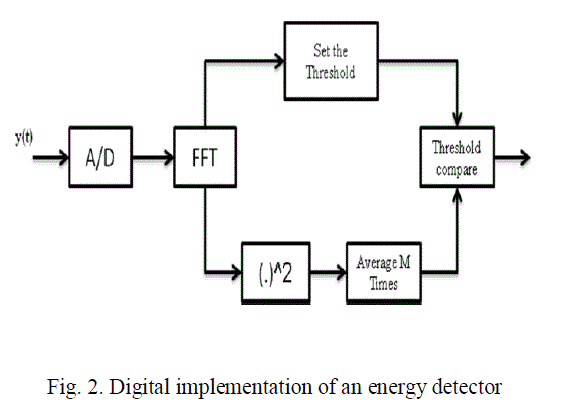 |
| The process flow of the energy detector is, the received signal is passed through the ADC then calculate the FFT coefficient values then squared those values and average over the observation interval. Then the output of the detector is compared to a pre defined threshold value to decide whether the primary user is present or not. |
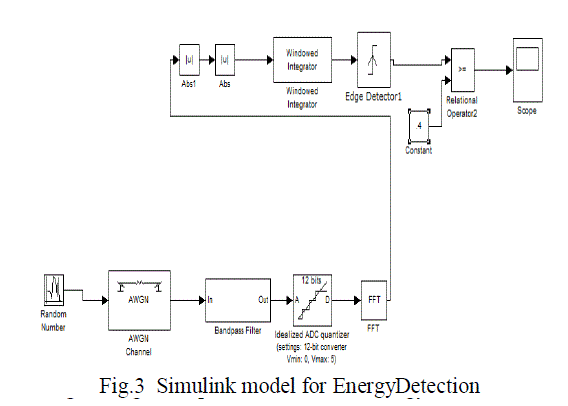 |
| Fig. 3.gives the Simulink based model for energy detection using FFT. Here, the analog signal is first filtered through a bandpass filter and then converted into a digital signal. A 12-bit ADC quantizer (Vmin = 0V, Vmax = 5V) is used. This output is then passed through an FFT to get the corresponding coefficients. The signal is converted from time domain to the frequency domain by the FFT block.The magnitude of the received signal is then taken and it is squared. A minimum amount of signal is considered to be noise. The received signal is assumed to be present if and only if this threshold is crossed. This is done with the help of a relational operator which is placed in the comparator diagram. |
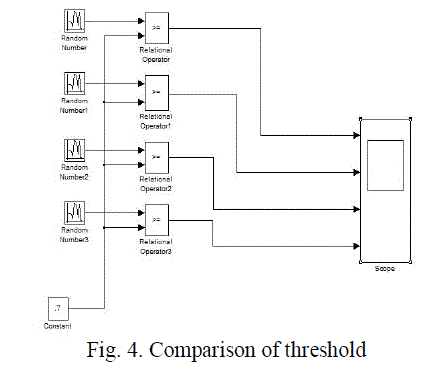 |
| Fig 4 shows threshold comparison of 4 users using energy detection (ED) method. There are 4 users with different signal values which are compared with threshold value. Threshold value is set at 0.7 and is generated using constant block. Relational Operator compares the input signal value with threshold signal value and the difference of both values shown on Scope. |
RESULTS AND DISCUSSIONS |
| Fig 5 shows the output result of Energy Detection method. Threshold is set to 0.4 and if user will cross the threshold value than user is present otherwise user will be idle and at that instant secondary user can occupy space. |
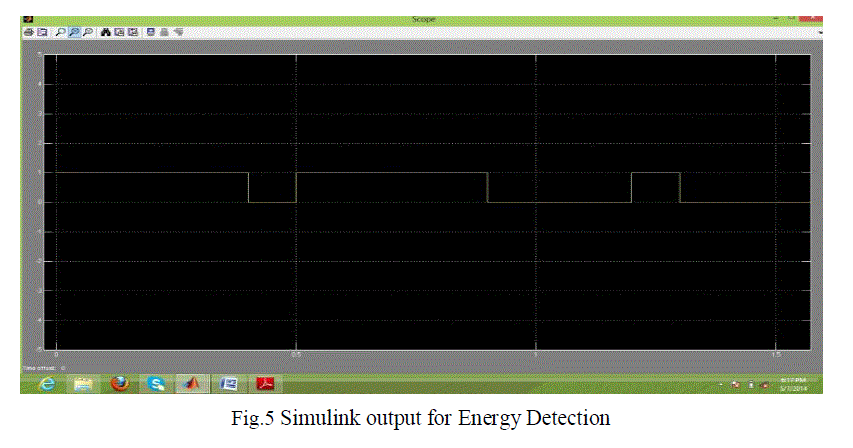 |
| In fig.6 we can see that threshold value is set at (0.7). Total number of users is 4. The user who will cross the threshold value is assumed to be present and who will not cross threshold value is assumed to be idle. As shown in graph that 1st and 3rd user cross the threshold value so they are assumed to be present. 2ndand4th user does not cross the threshold value so they are assumed to be idle. |
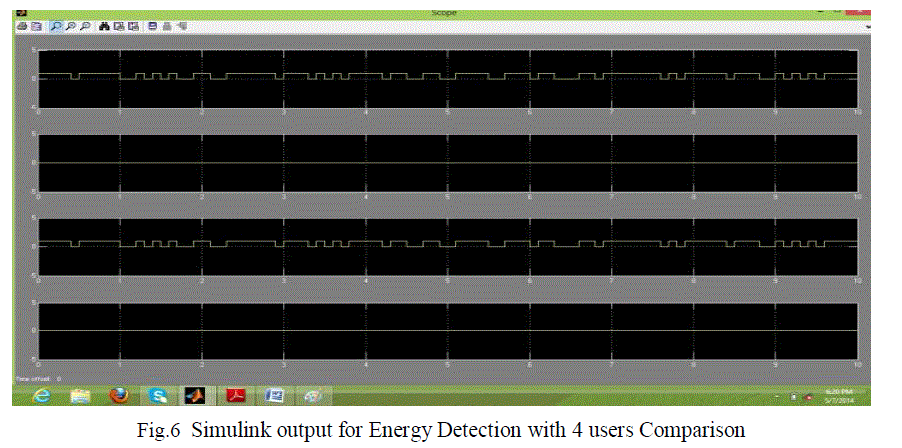 |
| In fig.7 we can see that threshold value is set at (0.7).As shown in graph that all 4 users cross the threshold level so they are present and no idle user. |
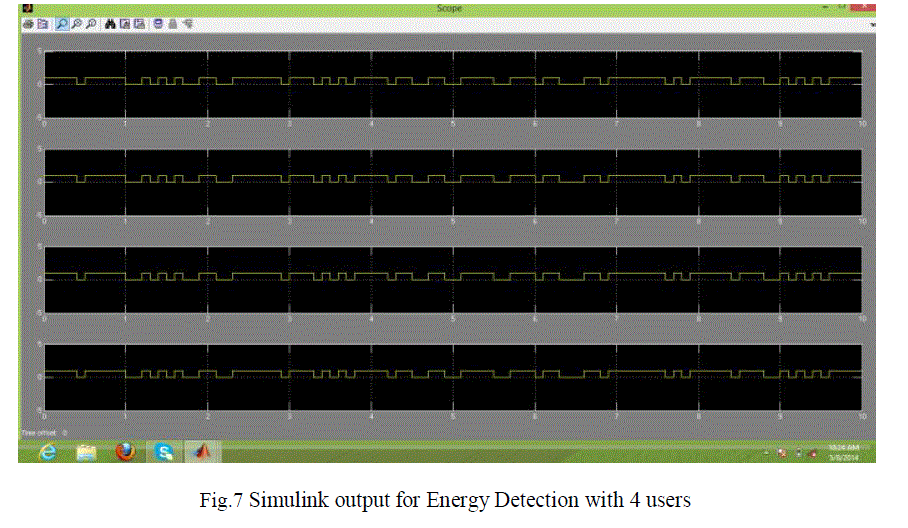 |
CONCLUSION |
| This paper has implemented Simulink based spectrum sensing. The energy detection is carried out for 4 users.The presence or absence of the primary user is decided based on the threshold.Energy detection has been adopted as an alternative spectrum sensing method for CRs due to its simple circuit in the practical implementation and no information requires about the signal needed to detect. |
References |
|